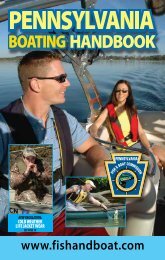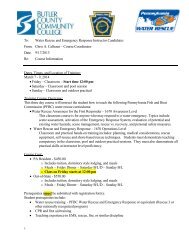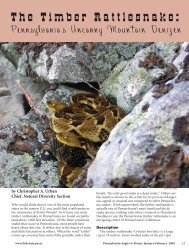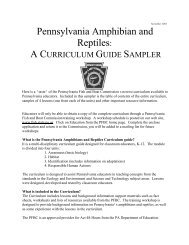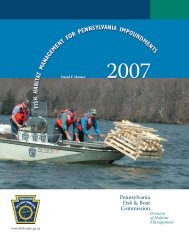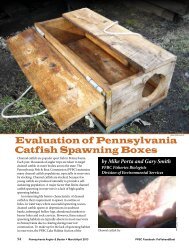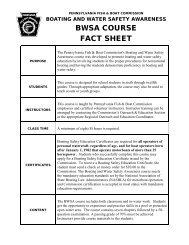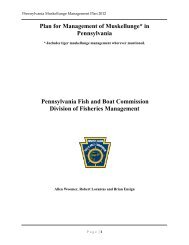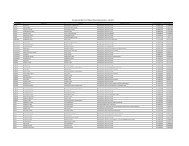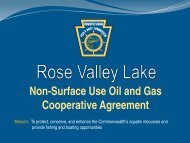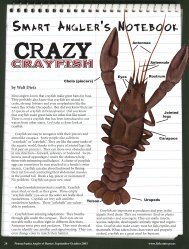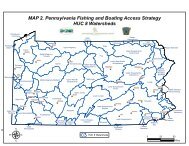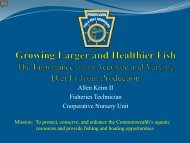Lehigh River Water Trail – Northern Section - Pennsylvania Fish and ...
Lehigh River Water Trail – Northern Section - Pennsylvania Fish and ...
Lehigh River Water Trail – Northern Section - Pennsylvania Fish and ...
You also want an ePaper? Increase the reach of your titles
YUMPU automatically turns print PDFs into web optimized ePapers that Google loves.
• Wear your life jacket. Some 80 percent of all recreational<br />
boating fatalities happen to people who are not wearing a life<br />
jacket.<br />
• Expect to get wet. Even the best paddlers sometimes capsize or<br />
swamp their boats. Bring extra clothing in a waterproof bag.<br />
• Be prepared to swim. If the water looks too hazardous to swim<br />
in, don’t go paddling.<br />
• If you capsize, hold on to your boat, unless it presents a lifethreatening<br />
situation. If floating in current, position yourself on<br />
the upstream side of the capsized boat.<br />
• Scout ahead whenever possible. Know the river. Avoid<br />
surprises.<br />
• Be prepared for the weather. Get a forecast before you go.<br />
Sudden winds <strong>and</strong> rain are common <strong>and</strong> can turn a pleasant trip<br />
into a risky, unpleasant venture.<br />
• One wearable, Coast Guard-approved personal flotation device (PFD<br />
or life jacket) in serviceable condition <strong>and</strong> of the appropriate sizeis<br />
required for each person in your boat. If your boat is 16 feet or<br />
longer, one throwable device (seat cushion or ring buoy) is required.<br />
Canoes <strong>and</strong> kayaks, regardless of length, are not required to carry a<br />
throwable device.<br />
• Life jackets must be worn by all children 12 years old <strong>and</strong> younger<br />
on all boats 20 feet or less in length while under way, <strong>and</strong> on all<br />
canoes <strong>and</strong> kayaks. Others are strongly encouraged to wear a PFD at<br />
all times on the water.<br />
• All boats must display an anchor light (a white light visible 360<br />
degrees) when at anchor between sunset <strong>and</strong> sunrise. Boats can use a<br />
lantern or clip-on battery-powered unit to meet this requirement.<br />
• All powered boats must show running lights between sunset <strong>and</strong><br />
sunrise. Between sunset <strong>and</strong> sunrise, unpowered boats must carry a<br />
white light (visible 360 degrees), installed or portable, ready to be<br />
displayed in time to avoid a collision.<br />
The size of the <strong>Lehigh</strong> <strong>River</strong> <strong>and</strong> the releases from the Francis E.<br />
Walter Dam make the river navigable in some way most days of the<br />
year. There are exceptions, however, particularly in the northern<br />
section of the <strong>Water</strong> <strong>Trail</strong> (above the <strong>Lehigh</strong> Gap), which should be<br />
monitored carefully in conditions of high flow. The northern section<br />
of the <strong>Water</strong> <strong>Trail</strong> where it passes through the <strong>Lehigh</strong> Gorge State<br />
Park contains Class II <strong>and</strong> III rapids requiring considerable expertise.<br />
It is not permitted for open canoes to float through this reach without<br />
special flotation devices installed in your boat. Nonetheless, some of<br />
the most exciting canoeing, rafting, <strong>and</strong> kayaking in the East is found<br />
here. The southern section is generally more subdued, but has some<br />
exciting rapids interspersed within its slower sections. This map will<br />
identify these areas for you. Remember, however, that due to<br />
intermittent water releases from the Francis E. Walter Dam, the water<br />
flow can be higher than recent rain activity would seem to indicate it<br />
should be. On the other h<strong>and</strong>, extreme drought conditions don’t<br />
usually halt navigation; it only makes the boater’s course more<br />
me<strong>and</strong>ering. There is truly something for everyone here <strong>–</strong> the expert<br />
looking for adventure <strong>and</strong> the novice paddling family looking for a<br />
gentle ride. Paddling when air temperatures are below 55° Fahrenheit<br />
is unsafe. PFDs should be worn by all occupants at all times. If<br />
someone else gets in trouble <strong>and</strong> you do not have your PFD on, you<br />
might both drown. Just wear it!<br />
PADDLING SAFETY TIPS<br />
PENNSYLVANIA BOATING REGULATIONS<br />
FLOATING THE RIVER<br />
• Wear wading shoes or tennis shoes with wool, polypropylene,<br />
pile or neoprene socks.<br />
• Never take your boat over a low-head dam.<br />
• Portage (carry) your boat around any section of water about<br />
which you feel uncertain.<br />
• Never boat alone. Boating safety increases with numbers.<br />
• Keep painter lines (ropes tied to the bow) <strong>and</strong> any other roped<br />
coiled <strong>and</strong> secured.<br />
• Never tie a rope to yourself or to another paddler, especially a<br />
child.<br />
• Kneel to increase your stability before entering rougher water,<br />
like a rapid.<br />
• If you collide with an obstruction, lean toward it. This will<br />
usually prevent your capsizing or flooding the boat.<br />
• File a float plan with a reliable person, indicating where you are<br />
going <strong>and</strong> when you will return. Remember to contact the<br />
person when you have returned safely.<br />
• All motorboats are required to carry a sound-producing mechanical<br />
device audible for a half-mile. Athletic whistles meet this<br />
requirement.<br />
• All motorboats must be registered, regardless of where they launch.<br />
• Unpowered boats (canoes, kayaks, rowboats, rafts) using<br />
<strong>Pennsylvania</strong> <strong>Fish</strong> & Boat Commission access areas must either be<br />
registered OR display a valid launch permit. Launch permits can be<br />
purchased on the web at www.fish.state.pa.us. Click the “Outdoor<br />
Shop” icon.<br />
• Operating watercraft, including canoes, kayaks, <strong>and</strong> rafts, under the<br />
influence of alcohol or drugs is illegal. The law is strongly enforced<br />
for user safety. For further information on boating regulations,<br />
contact the <strong>Pennsylvania</strong> <strong>Fish</strong> & Boat Commission at<br />
www.fish.state.pa.us.<br />
There are several river outfitters <strong>and</strong> river guides in the <strong>Lehigh</strong><br />
<strong>River</strong> valley, mostly in the northern section. Contact the regional<br />
tourist promotion agencies for a current list of outfitters. Many of<br />
these operators can also provide helpful information on current river<br />
conditions. All access points are indicated on the map, some of which<br />
are “primitive,” which means they are more suitable for canoes <strong>and</strong><br />
other car-top boats. In addition, Wildl<strong>and</strong>s Conservancy (a non-profit<br />
conservation organization) operates its Bike & Boat<br />
education/recreation program for groups of all sizes <strong>and</strong> ages.<br />
Contact them at www.wildl<strong>and</strong>spa.org or 610/965.4397 x36.



